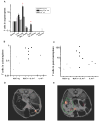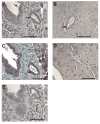Inflammation driven by overexpression of the hypoglycosylated abnormal mucin 1 (MUC1) links inflammatory bowel disease and pancreatitis
- PMID: 20084048
- PMCID: PMC2859977
- DOI: 10.1097/MPA.0b013e3181bd6501
Inflammation driven by overexpression of the hypoglycosylated abnormal mucin 1 (MUC1) links inflammatory bowel disease and pancreatitis
Abstract
Objective: Pancreatitis occurs as an extraintestinal complication of inflammatory bowel disease (IBD), but the cause is poorly understood. Mucin 1 (MUC1) is overexpressed in an abnormal, hypoglycosylated form on the colonic epithelium in human IBD where it contributes to inflammation. MUC1 is also expressed on pancreatic ductal epithelia. We tested the possibility that in IBD, MUC1 expression on pancreatic ducts is also abnormal leading to inflammation and pancreatitis.
Methods: We used MUC1/interleukin-10 mice that develop IBD. We imaged abnormal MUC1 expression in these mice by adoptively transferring T cells from T cell receptor transgenic mice specific for abnormal MUC1. Cells were labeled with a novel perfluorocarbon tracer reagent and quantified and visualized in vivo using high-throughput F nuclear magnetic resonance spectroscopy and magnetic resonance imaging.
Results: MUC1-specific T cells migrated to the colon in mice with IBD and also to the pancreas. Immunohistochemistry confirmed increased expression on the pancreatic ducts of the abnormal MUC1 seen in the colon and the presence of cellular infiltrate.
Conclusions: Migration of MUC1-specific T cells to the colon and the pancreas in diseased mice suggests that pancreatitis is an extraintestinal site of IBD, characterized by proinflammatory abnormal expression of MUC1. Therapies directed against abnormal MUC1 have the potential of targeting the disease in both sites.
Figures



Similar articles
-
Aberrant expression of MUC1 mucin in pediatric inflammatory bowel disease.Pediatr Dev Pathol. 2010 Jan-Feb;13(1):24-31. doi: 10.2350/08-06-0479.1. Pediatr Dev Pathol. 2010. PMID: 19025220
-
Vaccine against MUC1 antigen expressed in inflammatory bowel disease and cancer lessens colonic inflammation and prevents progression to colitis-associated colon cancer.Cancer Prev Res (Phila). 2010 Apr;3(4):438-46. doi: 10.1158/1940-6207.CAPR-09-0194. Epub 2010 Mar 23. Cancer Prev Res (Phila). 2010. PMID: 20332301 Free PMC article.
-
Cutting edge: transgenic expression of human MUC1 in IL-10-/- mice accelerates inflammatory bowel disease and progression to colon cancer.J Immunol. 2007 Jul 15;179(2):735-9. doi: 10.4049/jimmunol.179.2.735. J Immunol. 2007. PMID: 17617560
-
MUC1 Mucin: A Putative Regulatory (Checkpoint) Molecule of T Cells.Front Immunol. 2018 Oct 22;9:2391. doi: 10.3389/fimmu.2018.02391. eCollection 2018. Front Immunol. 2018. PMID: 30405607 Free PMC article. Review.
-
Expression of mucin antigens in human cancers and its relationship with malignancy potential.Pathol Int. 1997 Dec;47(12):813-30. doi: 10.1111/j.1440-1827.1997.tb03713.x. Pathol Int. 1997. PMID: 9503463 Review.
Cited by
-
Prevention of colitis-associated colon cancer using a vaccine to target abnormal expression of the MUC1 tumor antigen.Oncoimmunology. 2012 May 1;1(3):263-270. doi: 10.4161/onci.18950. Oncoimmunology. 2012. PMID: 22737601 Free PMC article.
-
Mucin-1 expression and localization in epithelial cells shows characteristic and distinct patterns in inflammatory bowel diseases and colorectal cancer.Int J Clin Exp Pathol. 2019 May 1;12(5):1731-1737. eCollection 2019. Int J Clin Exp Pathol. 2019. PMID: 31933991 Free PMC article.
-
Healing of intestinal inflammation by IL-22.Inflamm Bowel Dis. 2012 Sep;18(9):1777-84. doi: 10.1002/ibd.22929. Epub 2012 Feb 22. Inflamm Bowel Dis. 2012. PMID: 22359410 Free PMC article. Review.
-
Tracking immune cells in vivo using magnetic resonance imaging.Nat Rev Immunol. 2013 Oct;13(10):755-63. doi: 10.1038/nri3531. Epub 2013 Sep 10. Nat Rev Immunol. 2013. PMID: 24013185 Free PMC article. Review.
-
Method for estimation of apoptotic cell fraction of cytotherapy using in vivo fluorine-19 magnetic resonance: pilot study in a patient with head and neck carcinoma receiving tumor-infiltrating lymphocytes labeled with perfluorocarbon nanoemulsion.J Immunother Cancer. 2023 Jun;11(6):e007015. doi: 10.1136/jitc-2023-007015. J Immunother Cancer. 2023. PMID: 37339797 Free PMC article.
References
-
- Xavier RJ, Podolsky DK. Unravelling the pathogenesis of inflammatory bowel disease. Nature. 2007;448(7152):427–34. - PubMed
-
- Su CG, Judge TA, Lichtenstein GR. Extraintestinal manifestations of inflammatory bowel disease. Gastroenterol Clin North Am. 2002;31(1):307–27. - PubMed
-
- Gurian LE, Keeffe EB. Pancreatic insufficiency associated with ulcerative colitis and pericholangitis. Gastroenterology. 1982;82(3):581–5. - PubMed
Publication types
MeSH terms
Substances
Grants and funding
LinkOut - more resources
Full Text Sources
Medical
Research Materials
Miscellaneous

